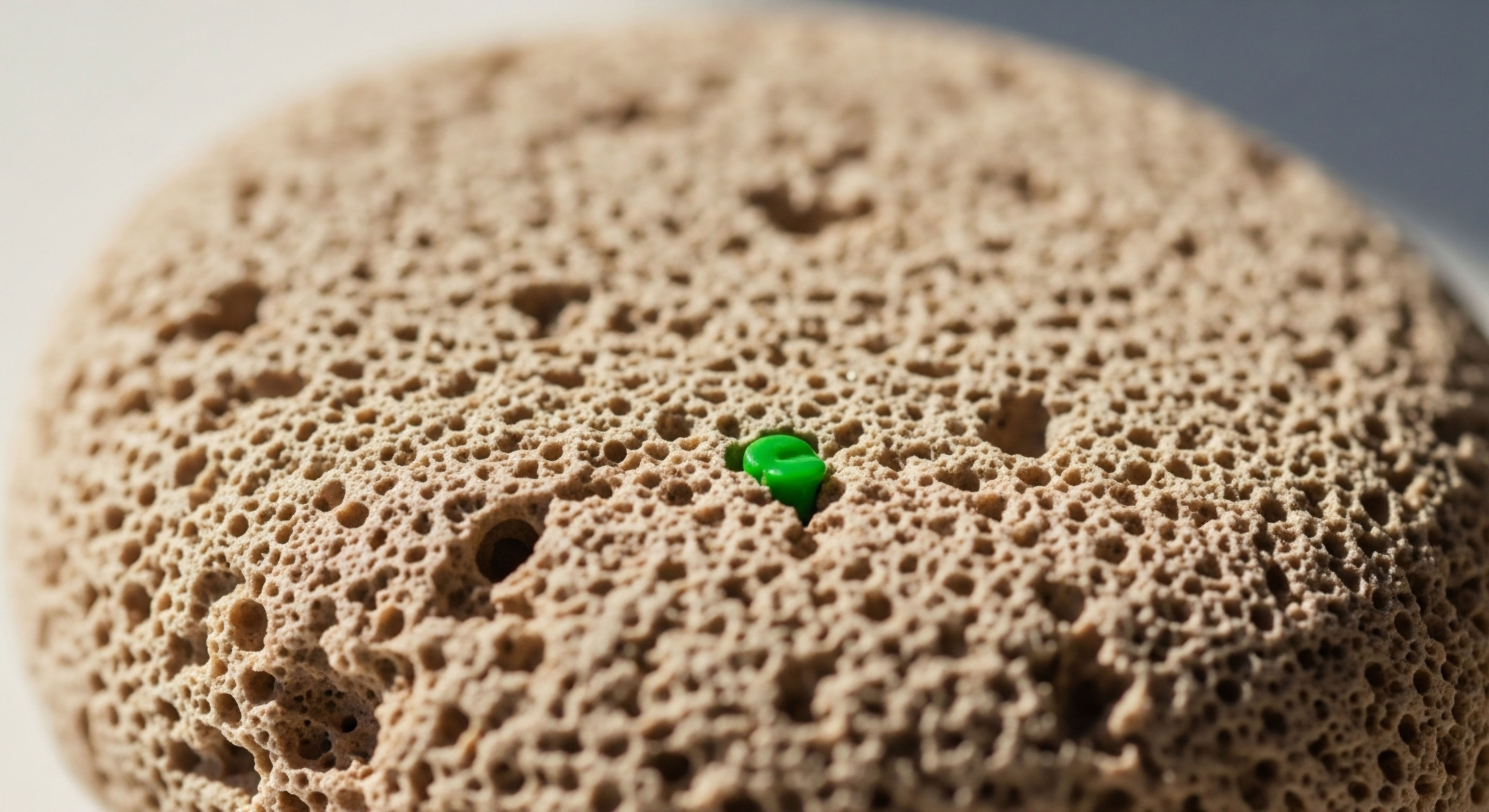

Fundamentals
Perhaps you have experienced those weeks each month when a shadow seems to fall, dimming your vitality and disrupting your sense of self. It is a familiar pattern of intense mood shifts, irritability, and physical discomfort that arrives with a cyclical predictability, only to recede with the onset of menstruation.
This experience, often dismissed or misunderstood, speaks to a profound interplay within your biological systems, particularly the delicate balance of your endocrine function. Understanding this personal journey ∞ the fluctuations within your own body ∞ marks the first step toward reclaiming your inherent function and well-being.
Premenstrual Dysphoric Disorder, or PMDD, extends beyond typical premenstrual syndrome. It represents a severe, debilitating condition rooted in an exaggerated sensitivity to normal hormonal changes during the luteal phase of the menstrual cycle. While hormonal levels themselves may appear within typical ranges, the body’s response to these shifts can be profoundly dysregulated. This heightened sensitivity often has a basis in your genetic makeup, suggesting that some individuals are predisposed to experiencing these intense reactions.

Genetic Blueprints and Hormonal Sensitivity
Research indicates a significant genetic component to PMDD, with studies suggesting that approximately 56% of the predisposition to this condition can be attributed to inherited factors. This means that your biological blueprint can influence how your body processes and reacts to the natural ebb and flow of hormones like estrogen and progesterone. Specific genetic variations may affect the sensitivity of hormone receptors or the pathways involved in neurotransmitter synthesis and breakdown.
PMDD involves an exaggerated biological response to normal hormonal fluctuations, often influenced by genetic predispositions.
Consider the intricate dance between your hormones and your brain chemistry. Estrogen and progesterone, while essential for reproductive health, also exert considerable influence over neurotransmitters such as serotonin, which plays a central role in mood regulation. For individuals with PMDD, even typical changes in these sex hormones can trigger an amplified response in the brain’s serotonin system, leading to the characteristic mood disturbances. This is not a matter of willpower; it is a biological reality shaped by your unique physiology.

The Daily Rhythms and Their Biological Impact
While genetic predispositions establish a foundational susceptibility, lifestyle factors act as powerful modulators, either alleviating or intensifying PMDD symptoms. Your daily choices interact dynamically with your genetic blueprint, influencing how your body expresses its inherent tendencies. This interaction highlights the profound connection between your external environment and your internal biological landscape.

Dietary Patterns and Metabolic Harmony
The food you consume provides the building blocks and energetic fuel for every cellular process, including hormone synthesis and neurotransmitter function. A diet rich in whole, unprocessed foods, complex carbohydrates, and healthy fats supports metabolic stability, which in turn can help regulate hormonal balance. Conversely, patterns of consumption high in refined sugars, excessive caffeine, and processed foods can disrupt blood glucose regulation, exacerbate inflammation, and potentially worsen hormonal fluctuations, thereby intensifying PMDD symptoms.
- Nutrient Density ∞ Prioritizing foods rich in magnesium, calcium, and B vitamins can support neurotransmitter production and reduce symptom severity.
- Blood Glucose Stability ∞ Consistent intake of protein and fiber helps prevent sharp spikes and drops in blood sugar, which can otherwise destabilize mood.
- Gut Microbiome Health ∞ A diverse and healthy gut flora influences the estrobolome, a collection of gut bacteria that metabolize estrogen, thereby affecting overall estrogen levels and balance.

Movement, Rest, and Stress Regulation
Regular physical activity serves as a potent tool for modulating mood and reducing stress, both of which are critical for PMDD management. Engaging in consistent, moderate exercise can improve hormonal balance, enhance sleep quality, and reduce systemic inflammation. Similarly, prioritizing adequate, restorative sleep is non-negotiable. Sleep deprivation can disrupt circadian rhythms, elevate stress hormones like cortisol, and further dysregulate neurotransmitter systems, making PMDD symptoms more pronounced.
Stress itself, whether acute or chronic, significantly impacts the hypothalamic-pituitary-adrenal (HPA) axis, the body’s central stress response system. Chronic activation of this axis can interfere with the delicate balance of the hypothalamic-pituitary-gonadal (HPG) axis, which governs reproductive hormones. This interconnectedness means that effective stress management techniques, such as mindfulness or deep breathing, are not merely coping mechanisms; they are direct biological interventions that can mitigate the severity of PMDD.


Intermediate
Moving beyond the foundational understanding, we can explore how specific clinical protocols and lifestyle interventions intersect with these genetic predispositions to optimize overall physiological function, thereby indirectly influencing PMDD management. The goal is to recalibrate the body’s internal messaging service, ensuring that its signals are clear and balanced, even in the face of inherent sensitivities.

Optimizing Endocrine System Support
While PMDD is not directly treated with standard hormone replacement therapy (HRT) in the same way that menopausal symptoms are, a comprehensive approach to hormonal health can create a more stable internal environment. For individuals experiencing broader hormonal imbalances alongside PMDD, addressing these underlying issues can alleviate systemic stress on the endocrine system. This might involve carefully considered hormonal optimization protocols tailored to individual needs, focusing on the broader context of endocrine well-being.

Testosterone Optimization Protocols
For women, optimizing testosterone levels, often overlooked, can contribute to overall vitality and mood stability. Low-dose Testosterone Cypionate, typically administered weekly via subcutaneous injection (e.g. 0.1 ∞ 0.2ml), can support energy levels, libido, and mood. This is not a direct PMDD treatment, but rather a strategy to enhance overall endocrine resilience. The body’s systems are interconnected; supporting one aspect of hormonal balance can have positive ripple effects across others, including neurotransmitter pathways that influence mood.
For men, Testosterone Replacement Therapy (TRT) protocols, such as weekly intramuscular injections of Testosterone Cypionate (200mg/ml), are designed to address symptoms of low testosterone. These protocols often include adjunctive medications like Gonadorelin (2x/week subcutaneous injections) to maintain natural testosterone production and fertility, and Anastrozole (2x/week oral tablet) to manage estrogen conversion. While distinct from PMDD, these protocols exemplify the precision involved in biochemical recalibration, a principle that extends to managing complex hormonal sensitivities.
Targeted hormonal optimization can indirectly support PMDD management by enhancing overall endocrine resilience and stability.

The Role of Progesterone and Estrogen Balance
For women, particularly those in peri-menopause or post-menopause, the strategic use of Progesterone is a key component of hormonal balance. Progesterone has calming effects on the central nervous system, partly through its metabolite allopregnanolone, which interacts with GABA receptors.
In PMDD, there is often an exaggerated response to normal fluctuations of progesterone and allopregnanolone, rather than a deficiency. Therefore, while exogenous progesterone might be used in other contexts, its application in PMDD requires careful consideration of individual sensitivity. The goal is to stabilize the hormonal environment, not simply to increase levels.
Pellet therapy, offering long-acting testosterone, can also be considered for women, sometimes with Anastrozole when appropriate, to maintain stable hormone levels. This consistent delivery can help avoid the peaks and troughs that might exacerbate sensitivities in genetically predisposed individuals.

Peptide Therapy and Systemic Support
Beyond traditional hormones, specific peptides offer avenues for systemic support that can influence factors relevant to PMDD, such as inflammation, stress response, and sleep quality. These agents work by signaling specific pathways within the body, acting as sophisticated messengers to restore balance.
| Peptide | Primary Benefit Areas | Relevance to PMDD Context |
|---|---|---|
| Sermorelin / Ipamorelin / CJC-1295 | Growth hormone release, sleep quality, body composition | Improved sleep and recovery can mitigate stress and mood dysregulation. |
| Tesamorelin | Visceral fat reduction, metabolic health | Metabolic health influences inflammation and hormonal signaling. |
| Hexarelin / MK-677 | Growth hormone release, appetite regulation | Indirectly supports metabolic stability and overall well-being. |
| PT-141 | Sexual health, libido | Addresses a common symptom of hormonal imbalance and low vitality. |
| Pentadeca Arginate (PDA) | Tissue repair, anti-inflammatory properties | Reducing systemic inflammation can lessen PMDD symptom severity. |
The application of peptides like Pentadeca Arginate (PDA), known for its tissue repair and anti-inflammatory properties, represents a systems-based approach. Chronic low-grade inflammation is increasingly recognized as a contributing factor to mood disorders and heightened pain sensitivity, both of which are hallmarks of PMDD. By addressing underlying inflammatory processes, peptides can help create a more resilient physiological state, making the body less reactive to hormonal shifts.

Lifestyle Interventions as Clinical Modulators
The daily practices of nutrition, movement, and stress regulation are not merely supplementary; they are powerful clinical modulators that interact directly with genetic predispositions. For someone with a genetic susceptibility to PMDD, these interventions become even more critical. They can influence gene expression (epigenetics), neurotransmitter synthesis, and the overall resilience of the endocrine and nervous systems.
Consider the impact of consistent physical activity. Regular exercise can upregulate genes involved in serotonin synthesis and receptor sensitivity, potentially counteracting some of the genetic tendencies toward dysregulation in PMDD. Similarly, mindfulness practices can alter brain activity patterns, fostering a more balanced HPA axis response and reducing the physiological impact of stress. These are not simply “healthy habits”; they are precise biological interventions that can shift the trajectory of a genetically influenced condition.


Academic
To truly comprehend the intersection of lifestyle and genetic predispositions in PMDD management, we must delve into the intricate molecular and systems-level interactions that govern this condition. This requires an understanding of neuroendocrine feedback loops, genetic polymorphisms, and the emerging field of epigenetics, which collectively paint a comprehensive picture of biological vulnerability and resilience.

Neuroendocrine Axes and PMDD Pathophysiology
The core of PMDD pathophysiology lies in an abnormal central nervous system response to normal ovarian steroid fluctuations, particularly progesterone and its neuroactive metabolites like allopregnanolone. While circulating progesterone levels are typically within the physiological range in women with PMDD, their brains exhibit an altered sensitivity to allopregnanolone’s modulatory effects on the GABA-A receptor.
This receptor is the primary inhibitory neurotransmitter system in the brain, and its proper function is critical for mood stability and anxiety regulation. Genetic variations in the GABA-A receptor subunits or enzymes involved in allopregnanolone metabolism may contribute to this altered sensitivity.
The Hypothalamic-Pituitary-Gonadal (HPG) axis, which orchestrates reproductive hormone cycles, is intimately connected with the Hypothalamic-Pituitary-Adrenal (HPA) axis, the body’s stress response system. Chronic activation of the HPA axis, often driven by lifestyle factors such as persistent stress, inadequate sleep, or poor nutrition, can dysregulate the HPG axis. This cross-talk can exacerbate the brain’s sensitivity to hormonal shifts, making individuals with genetic predispositions to PMDD even more vulnerable to symptom expression.
PMDD involves altered brain sensitivity to neurosteroids, influenced by genetic factors and modulated by the interconnected HPG and HPA axes.

Genetic Polymorphisms and Epigenetic Modulation
Specific genetic polymorphisms have been implicated in PMDD susceptibility. Variations in genes encoding estrogen receptors (e.g. ESR1, ESR2), progesterone receptors (PGR), and components of the serotonin pathway (e.g. serotonin transporter gene, SLC6A4) are areas of active research. For instance, certain alleles of the SLC6A4 gene may lead to reduced serotonin reuptake efficiency, making individuals more susceptible to mood disturbances when serotonin levels fluctuate in response to hormonal changes.
This is where lifestyle factors exert their profound influence through epigenetics. Epigenetic modifications, such as DNA methylation and histone acetylation, do not alter the underlying DNA sequence but can change how genes are expressed. Nutritional components, physical activity, stress exposure, and even environmental toxins can induce these epigenetic changes.
For example, a diet rich in methyl donors (e.g. B vitamins, choline) can support optimal DNA methylation, potentially influencing the expression of genes related to neurotransmitter synthesis or hormone receptor sensitivity.
| Genetic Predisposition (Example) | Biological Mechanism | Lifestyle Modulator | Impact on PMDD |
|---|---|---|---|
| Serotonin Transporter Gene (SLC6A4) Polymorphisms | Altered serotonin reuptake efficiency, leading to exaggerated mood response to hormonal shifts. | Regular exercise, adequate sleep, stress management, nutrient-dense diet (e.g. tryptophan precursors, B vitamins). | Can optimize serotonin signaling, potentially buffering genetic susceptibility. |
| Estrogen Receptor Gene Variations (ESR1, ESR2) | Modified sensitivity of target tissues to estrogen, affecting brain regions involved in mood. | Balanced nutrition, gut microbiome support (estrobolome), healthy inflammatory response. | Supports balanced estrogen metabolism and receptor function. |
| GABA-A Receptor Subunit Polymorphisms | Altered brain response to allopregnanolone, impacting inhibitory neurotransmission. | Stress reduction techniques, magnesium supplementation, avoidance of alcohol/caffeine. | Can enhance GABAergic tone and reduce neuronal hyperexcitability. |

Inflammation, Gut-Brain Axis, and Metabolic Interplay
The role of systemic inflammation in PMDD is gaining significant attention. Chronic low-grade inflammation, often driven by lifestyle factors such as a pro-inflammatory diet, gut dysbiosis, or chronic stress, can directly impact brain function. Inflammatory cytokines can cross the blood-brain barrier, affecting neurotransmitter metabolism and neuronal plasticity, thereby contributing to mood disturbances.
The gut-brain axis represents another critical intersection. The gut microbiome, through its production of neurotransmitters, short-chain fatty acids, and its influence on the estrobolome, directly communicates with the brain and influences hormonal balance. Dysbiosis, an imbalance in gut bacteria, can lead to increased inflammation and altered estrogen metabolism, potentially exacerbating PMDD symptoms in genetically susceptible individuals.
Strategies to support gut health, such as probiotic supplementation and a fiber-rich diet, are therefore not merely digestive aids; they are interventions with systemic neuroendocrine implications.
Metabolic health, encompassing blood glucose regulation and insulin sensitivity, also plays a pivotal role. Insulin resistance, often a consequence of dietary patterns and sedentary lifestyles, can contribute to hormonal imbalances, including altered androgen and estrogen metabolism. This metabolic dysregulation creates a less stable internal environment, making the body more reactive to inherent genetic sensitivities.
A comprehensive approach to PMDD management, therefore, necessitates a deep consideration of these interconnected biological systems, recognizing that personalized wellness protocols must address both genetic predispositions and their dynamic interaction with daily lived experience.

References
- Miyé. “Premenstrual dysphoric disorder ∞ How to manage symptoms of PMDD.” Miyé, 6 Mar. 2025.
- Contemporary OB/GYN Associates. “Effective Strategies for Managing PMS and PMDD.” Contemporary OB/GYN Associates.
- Continental Hospitals. “Premenstrual Dysphoric Disorder ∞ Symptoms and Causes.” Continental Hospitals, 12 Feb. 2024.
- Parry, Barbara L. et al. “Recent advances in understanding/management of premenstrual dysphoric disorder/premenstrual syndrome.” PMC – PubMed Central, 28 Apr. 2022.
- Adam, Chloe. “How To Nutritionally Support PMDD.” Chloe Adam Nutrition, 11 Jan. 2024.

Reflection
As you consider the intricate connections between your genetic blueprint and your daily choices, reflect on your own unique biological system. This knowledge is not merely academic; it is a powerful lens through which to view your personal health journey. Understanding the underlying mechanisms of conditions like PMDD allows for a more precise and compassionate approach to your well-being.

What Does Your Body Communicate?
Every symptom, every fluctuation, represents a communication from your body. Learning to interpret these signals, informed by scientific understanding, transforms a frustrating experience into an opportunity for profound self-discovery and recalibration. Your body possesses an innate intelligence, and with the right support, it can often restore its inherent balance.
The path to vitality is deeply personal, requiring a tailored approach that respects your unique genetic predispositions and the dynamic influence of your lifestyle. This exploration is the first step, inviting you to engage with your health not as a passive recipient, but as an active participant in your own biological optimization.



